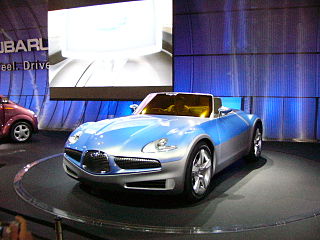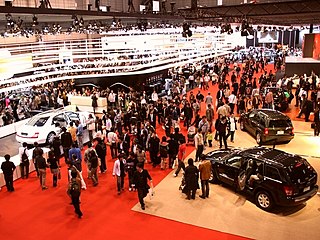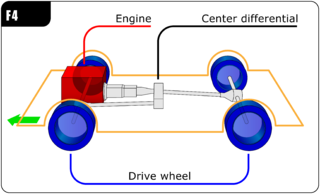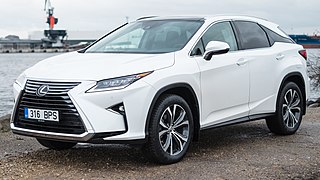
The Subaru Forester is a compact crossover SUV that has been manufactured by Subaru since 1997. The first generation was built on the platform of the Impreza in the style of a taller station wagon, a style that continued to the second generation, while the third-generation model onwards moved towards a crossover SUV design. A performance model was available for the second-generation Forester in Japan as the Forester STi.

The Honda Insight is a hybrid electric vehicle that is manufactured and marketed by Honda. Its first generation was a two-door, two passenger liftback (1999–2006) and in its second generation was a four-door, five passenger liftback (2009–2014). In its third generation, it became a four-door sedan (2018–2022). It was Honda's first model with Integrated Motor Assist system and the most fuel efficient gasoline-powered car available in the U.S. without plug-in capability — for the length of its production run.

The Subaru B9 Scrambler is an open two-seat concept sports car from Subaru featuring classic styling. It is 4.2 metres (165.4 in) long and powered by a 140 hp (104 kW) gasoline-electric hybrid engine. It was designed by Andreas Zapatinas.

The Ford Escape is a compact crossover SUV sold by Ford since the 2001 model year. The first Ford SUV derived from a car platform, the Escape was slotted below the Ford Explorer in size; the Escape is currently sized between the Ford EcoSport and Ford Edge. In another first, the 2004 Ford Escape Hybrid was the first hybrid-electric vehicle from Ford, and the first hybrid produced as an SUV.
Hybrid Synergy Drive (HSD), also known as Toyota Hybrid System II, is the brand name of Toyota Motor Corporation for the hybrid car drive train technology used in vehicles with the Toyota and Lexus marques. First introduced on the Prius, the technology is an option on several other Toyota and Lexus vehicles and has been adapted for the electric drive system of the hydrogen-powered Mirai, and for a plug-in hybrid version of the Prius. Previously, Toyota also licensed its HSD technology to Nissan for use in its Nissan Altima Hybrid. Its parts supplier Aisin Seiki Co. offers similar hybrid transmissions to other car companies.

The Japan Mobility Show (ジャパンモビリティショー) (TMS) is a biennial auto show held in October–November at the Tokyo Big Sight, Tokyo, Japan for cars, motorcycles and commercial vehicles. Hosted by the Japan Automobile Manufacturers Association (JAMA), it is a recognized international show by the Organisation Internationale des Constructeurs d'Automobiles, and normally sees more concept cars than actual production car introductions which is the reason why the auto press see the show as one of the motorshow's big five.
Hybrid vehicle drivetrains transmit power to the driving wheels for hybrid vehicles. A hybrid vehicle has multiple forms of motive power.

The Mitsubishi ESR (Ecological Science Research) is a hybrid electric vehicle (HEV) concept exhibited by Mitsubishi Motors at the 30th Tokyo Motor Show in 1993. It was designed to demonstrate the company's technological developments in alternative energy, and used a 70 kW AC induction motor to drive the front wheels. 28 alkaline batteries housed under the passenger compartment, and a rear-mounted 1.5-litre gasoline engine powered an onboard electrical generator system. It also recycled its own kinetic energy, and absorbed solar power through roof-mounted cells.

In automotive design, an F4, or front-engine, four-wheel drive (4WD) layout places the internal combustion engine at the front of the vehicle and drives all four roadwheels. This layout is typically chosen for better control on many surfaces, and is an important part of rally racing, as well as off-road driving. In terms of racing purposes, whether it be on-road or off-road, can be described as follows,
A team that pursues the Weak LS4WD architecture will minimize the development cost of the front-wheel drive system at the expense of having a larger rear powertrain. The Weak architecture produces a vehicle with a large powersplit between the front and rear powertrains, while the Strong architecture recommends a vehicle with more similar power and torque requirements for the front and rear.

Audi hybrid vehicles are hybrid electric vehicles created by the German carmaker, Audi. Some vehicles listed were concept vehicles, which utilised an internal combustion engine and an electric motor, and were used for research and development (R&D) for potential future use of the technology into possible series production. Audi launched its first hybrid concept car in 1989 called the Audi Duo, and was the first European company to sell a hybrid in 1997, though only in very small numbers.
Toyota concept vehicles are transportation devices manufactured or designed by automobile company Toyota from 2000 to 2009. As their name suggests, these vehicles were concepts, and, as such, many were never released to dealerships. Many were developed in conjunction with other corporations such as Sony or Subaru.
This is a list of concept vehicles from Toyota for the years 2010–2019.

The Hyundai Blue-Will is a plug-in petrol-electric hybrid concept compact car designed by the South Korean car manufacturer Hyundai Motor Company. The vehicle was debuted at the 2009 Seoul Motor Show in South Korea.

The Lexus RX is a luxury crossover SUV sold since 1998 by Lexus, a luxury division of Toyota. Originally released in its home market of Japan in late 1997 as the Toyota Harrier, export sales began in March 1998 as the Lexus RX. Considered as the first luxury crossover SUV, five generations of the RX have been produced to date, the first being compact in size, and the latter three classified as mid-size. Both front- and four-wheel drive configurations have been used on the RX series, and several gasoline powertrain options, including V6 engines and hybrid systems, have been offered. In the Lexus model lineup, the RX sits below the larger Lexus LX, and above the shorter and less wider, but taller GX SUV. The name "RX" stands for "Radiant Crossover". It has also been labelled as "Recreational Cross Country" in some markets. The RX's current Toyota counterpart is the Highlander/Kluger; past counterparts included the Harrier and Venza.

The Toyota 86 and the Subaru BRZ are 2+2 sports cars jointly developed by Toyota and Subaru, manufactured at Subaru's Gunma assembly plant.

The Subaru VIZIV is a series of hybrid concept sports SUVs designed and built by Subaru, the first of which was unveiled at the 2013 Geneva Motor Show. The VIZIV series included several signature Subaru design features, such as the use of horizontally-opposed engines and all-wheel drive, and built on prior Subaru hybrid concepts such as the B9SC, B5-TPH, and Hybrid Tourer by using a three-motor layout. Since 2016, the VIZIV concept cars have previewed styling for upcoming production automobiles, and the hybrid powertrain has been dropped in favor of a conventional gasoline engine and all-wheel-drive.

The Subaru B5-TPH was a concept shooting-brake coupe with a Turbo Parallel Hybrid (TPH) powertrain made by Fuji Heavy Industries (FHI), introduced at the 2005 Tokyo Motor Show.

The Subaru Crosstrek is a subcompact crossover SUV produced by Subaru since 2012. It is a successor to the Outback Sport in the United States and Canada, and the Impreza XV globally. Like the Outback Sport, the Crosstrek is a lifted Impreza hatchback with minor differences, though with a more substantial lift than the Outback Sport.

The Subaru WRX is an all-wheel drive sport compact car manufactured by the Japanese automaker Subaru, originally based on the Impreza created for the World Rally Championship in 1992. Subaru claimed the name WRX stands for "World Rally eXperimental". Starting with the 2015 models, the WRX lineup has been split from the Impreza, with a different body style that is not offered as an optional hatchback/wagon, being introduced as the separate Levorg model.


















